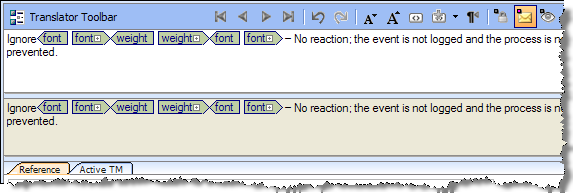|
|
Working with Inline Tags |
|
|
Working with Inline Tags |
Tags are found in many documentation file formats. They are generally used to describe text emphasis marks such as bold, underline, italic or hyperlinked text.
They are referred to as Inline Tags since they are included within the boundaries of a translatable segment.
Inline tags are displayed using graphical symbols such as ![]() and
and ![]() and they often appear in pairs. For example,
and they often appear in pairs. For example, ![]() denotes the start of a tag while
denotes the start of a tag while ![]() denotes the end of the tag.
denotes the end of the tag.
The text enclosed within these tags is affected by the tag. In this example, any text enclosed within the tag will be displayed in a Strong or bolded font.
In most cases, inline tags are not translated. However, they might need to be repositioned during the translation process to follow the logical change in sentence structure in the newly translated segment.

The Translator Toolbar renders inline tags and XML elements in a graphical format (see above).
Alchemy PUBLISHER has been designed to have the flexibility to enable the tags be modified, deleted, or moved during the translation process.
|
|
You can customize the list of inline tags by defining them in CustomTags.xml. This file is located on your desktop PC. For additional custom tag information, please refer to your \Documents and Settings\All Users\Alchemy Software\Publisher 2.5 folder. There are a number of custom tags defined for MS Word, Adobe FrameMaker and HTML file types. |